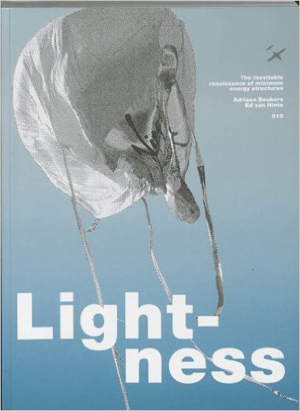Review of Lightness by Adriaan Beukers and Ed van Hinte
Adriaan Beukers and Ed van Hinte, Lightness: the Inevitable Renaissance of Minimum Energy Structures, Uitgeverij 010 Publishers, July 1998
Adriaan Beukers is at the Laboratory for structures and materials of the faculty of aerospace engineering, Delft University, the Netherlands. Erik Wong is a graphic designer. Writer Ed van Hinte has worked closely with them both. Together, they have gathered together a profusion of insightful charts and delightful photographs to explore the lightness of planes, balloons, bridges, chairs, tents and much architecture besides. The maths also looks indisputable, even if the text has a few flaws.
All constructions, Lightness points out,are related to transport in one way or another. They are loaded for at least a part of their lives and in many cases they are vehicles themselves (p12). The book displays a great chart on the declining relative importance of metals compared with high-modulus and now high-temperature polymers and elastomers, composites (metal-matrix, and increasingly ceramics-based), and tough engineering ceramics such as Al203 or Si3N4 (pp14-15).
Lightness argues that the reason metals are gradually decreasing in significance ‘is not that metal resources are being exhausted, but that the most widely used ones, steel and aluminium, are no longer capable of meeting long term requirements of price and performance. Research and development to achieve small improvements are becoming relatively expensive’ (pp13-16)
So far, so good. But the U-shaped recovery of non-metallic materials coincides, the authors maintain, with a change in the importance of weight: ‘Whereas in prehistoric times man had to be able to carry things himself, heaviness became important later on as he got more help from animals, slaves and, later on, from engines. Now lightness, or performance per energy unit, is quickly gaining significance because… cheap energy is getting scarce’ (p16).
But in a deflationary world, it is quite a presumption to say that the price of energy will increase – or that ‘the price we pay for energy is unjustifiably low’. It is also quite a presumption to say that world population will have doubled by 2040, as does Dr G J Wijers, pro-lightness Minister of Economic Affairs in the Netherlands, who, in the preface to this book, makes a familiar call for a sustainable economy.
The authors look back to nomadic tribes for inspiration on lightness. This is fun, but of a piece with looking forward to government decrees on lightness (all cars to be less than 1000kg, for example (p163)). I love the book, but I can’t go along with that.
@jameswoudhuysen I use my bicycle every day. Exercise and access to shopping without any parking meters and all that fuzz. But alfa-cyclists are the worst. They are competing at 40 mph and always acting rudely to get where they are going.
A PRO-CAR CYCLIST WRITES: 12-1pm tomorrow on #R4, will be talking bikes, cars, pedestrians, public transport – and #JeremyVine
Stimulating piece on the #CrisisOfCustomerService by clever @ClaerB @FT.
All that Clinton-era #CustomerExperience guff was always for the birds - certainly compared with, er, price.
The new thang? Often there is NO service - and thus no #CX!
Articles grouped by Tag
Bookmarks
Innovators I like

Robert Furchgott – discovered that nitric oxide transmits signals within the human body

Barry Marshall – showed that the bacterium Helicobacter pylori is the cause of most peptic ulcers, reversing decades of medical doctrine holding that ulcers were caused by stress, spicy foods, and too much acid

N Joseph Woodland – co-inventor of the barcode

Jocelyn Bell Burnell – she discovered the first radio pulsars

John Tyndall – the man who worked out why the sky was blue

Rosalind Franklin co-discovered the structure of DNA, with Crick and Watson

Rosalyn Sussman Yallow – development of radioimmunoassay (RIA), a method of quantifying minute amounts of biological substances in the body

Jonas Salk – discovery and development of the first successful polio vaccine

John Waterlow – discovered that lack of body potassium causes altitude sickness. First experiment: on himself

Werner Forssmann – the first man to insert a catheter into a human heart: his own

Bruce Bayer – scientist with Kodak whose invention of a colour filter array enabled digital imaging sensors to capture colour

Yuri Gagarin – first man in space. My piece of fandom: http://www.spiked-online.com/newsite/article/10421

Sir Godfrey Hounsfield – inventor, with Robert Ledley, of the CAT scanner

Martin Cooper – inventor of the mobile phone

George Devol – 'father of robotics’ who helped to revolutionise carmaking

Eugene Polley – TV remote controls

Thomas Tuohy – Windscale manager who doused the flames of the 1957 fire



0 comments